The CTU packing guidelines state in Section 4.4.1 in relation to placarding of containers carrying dangerous cargoes:
- 4.4.1.1 Placards (enlarged labels) (minimum size 250 mm x 250 mm) and, if applicable for maritime transport, "MARINE POLLUTANT" marks (minimum size of a side 250 mm) and other signs should be affixed to the exterior surfaces of a CTU or unit load or overpack to provide a warning that the contents of the unit are dangerous cargoes and present risks, unless the labels, marks or signs affixed to the packages are clearly visible from the exterior of the unit. This type of marking can be omitted on unit loads and overpacks if the hazard labels, markings or warning symbols are clearly visible from the outside.
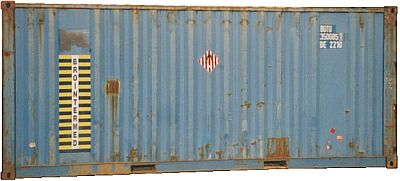 |
| Correct marking on a container side |
The container is loaded with Class 4.1 flammable solids.
 |
Correct marking on a container side |
The container is loaded with Class 3 goods, i.e. flammable liquids, which are also marine pollutants.
The CTU packing guidelines give additional instructions for affixing placards, these being explained in more detail in the CTU packing guidelines Point 4.4.1.2: This paragraph reads:
-
(4.4.1.1 contd.) If possible, the placards, hazard labels, markings or warning symbols on the outsides of the CTU should not be obscured when the CTU is opened.
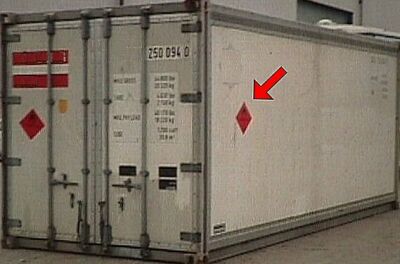 |
||
| Non-regulation affixing of a placard | ||
- 4.4.1.2 CTUs containing dangerous cargoes or residues of dangerous cargoes should clearly display placards and, if applicable for maritime transport, "MARINE POLLUTANT" marks or other signs as follows:
- a container, one on each side and, in the case of carriage by ocean-going vessel, also one on each of the ends of the unit;
- a railway wagon [railroad car], at least one on each side;
- any other CTU, at least one on both sides and on the back of the CTU and, in the case of a semitrailer, also one on the front of the CTU.
 |
|
| Correct marking of a container for maritime transport according to the CTU packing guidelines |
It has been proposed to mark the roof with a corresponding placard, in order to warn lifting gear or ground conveyor operators when picking up such a container. However, the regulations do not as yet contain any such obligation.
Point 4.4.1.2 of the CTU packing guidelines continues:
-
Placards on the sides of a CTU should be affixed in such a position that they are not obscured when the unit doors are opened.
The "if possible...not be obscured" of 4.4.1.1 has become an obligation: "should be affixed".
Point 4.4.1.3 deals with dangerous cargoes which present several risks:
-
Whenever dangerous cargoes present several risks, subsidiary risk placards should be displayed in addition to primary risk placards.
The regulations covering this area were amended in 2002. According to the old regulations, the primary risk placards had to carry the correct class number, while the subsidiary risk placard was not supposed to carry any class numbers.
 |
 |
 |
| Three old variants of primary and subsidiary risk placards | ||
The way this requirement was fulfilled was open to choice and it was of no significance whether the class numbers were obscured by being painted or stuck over or cut off.
| According to the regulations in force since 2002, both primary and subsidiary risk placards must carry the class numbers. | 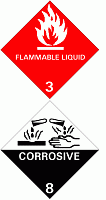 |
| New regulations: Primary and subsidiary risk placards bear class number. |
Point 4.4.1.3 of the CTU packing guidelines continues:
-
... CTUs containing cargoes of more than one class, however, need not bear a subsidiary risk placard if the hazard represented is already indicated by the primary risk placard.
 |
Dangerous cargo container carrying dangerous goods of various classes |
For dangerous cargo containers carrying dangerous goods of only one class, the regulations in point 4.4.1.6 of the CTU packing guidelines apply:
- Consignments of packaged dangerous cargoes of a single commodity, other than cargoes of class 1, which constitute a full load for the CTU should have the UN Number for the commodity displayed in black digits not less than 65 mm high either against a white background in the lower half of the class placard or on an orange rectangular panel not less than 120 mm high and 300 mm wide, with a 10 mm black border, to be placed immediately adjacent to the placard (see Annex 2). In those cases the UN Number should be displayed immediately adjacent to the Proper Shipping Name.
According to the IMDG Code, the regulation applies from a mass of 4,000 kg.
The container contains only one dangerous cargo, i.e. Class 5.1 oxidizing substances (agents), which increase the risk and intensity of fire, and are also corrosive. The (yellow) primary risk placard correctly carries the number 5.1, but the subsidiary risk placard does not carry the number 8 (also correct according to the old regulations), which has been obscured. According to the currently applicable regulations, this placard would also have to carry the class number 8.
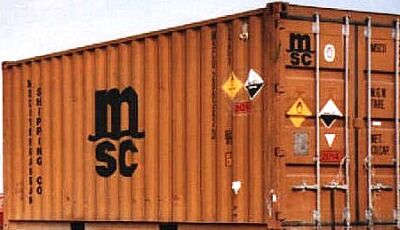 |
|
| Primary and subsidiary risk placards plus UN Number. | |
The placards have been incorrectly positioned. They are obscured when the door is opened.
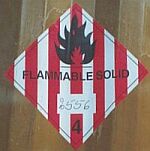 |
 |
||
| Correct: 4,000 kg consignment with hazardous materials, therefore UN number stated |
Correct: < 4,000 kg consignment with hazardous materials, therefore UN number not stated |
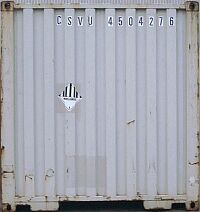 |
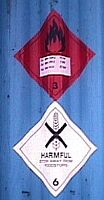 |
||
| Incorrect: < 4,000 kg consignment with hazardous materials, no UN number stated | Correct: two classes, therefore no UN Number (the placard is obsolete and class 6.1 has since been replaced with a death's head and the word "Toxic"). |
Point 4.4.1.9 of the CTU states the following:
- When solid carbon dioxide (CO2 - dry ice) or other expendable refrigerant is used for cooling purposes, a warning sign should be affixed to the outside of the doors so that it is clearly visible to any person operating the doors. The sign should warn of the possibility of an asphyxiating atmosphere. ...
| The name of the gas used as refrigerant should be inserted beneath the word WARNING. |  |
| Warning sign for CTUs in which dry ice or other expendable refrigerants are used for refrigeration purposes |
The IMDG Code recommends the following wording for the "Container Packing Certificate":
- When solid carbon dioxide (CO2 - dry ice) is used for cooling purposes, the container/vehicle is externally marked or labelled in a conspicuous place, such as, at the door end, with the words:
- "DANGEROUS CO2 (DRY ICE) INSIDE.
- VENTILATE THOROUGHLY BEFORE ENTERING."
The CTU packing guidelines contain a reminder that cargoes under fumigation may require special precautions:
- 4.4.1.10 As CTUs offered for shipment under fumigation may require special precautions, they should only be accepted with the agreement of the carrier and they should be identified to him prior to loading. CTUs under fumigation are now included in class 9 of the IMDG Code.
The following is stated about the labeling of such CTUs:
- 4.4.1.11 When a closed CTU or its contents has been fumigated and is to be shipped under fumigation, a warning sign should be affixed to the outside of the doors so that it is clearly visible to any person operating the door. An example of such a warning sign is given in Annex 2. The sign should state the fumigant, the method of fumigation employed and the date and time when it took place. The sign should only be removed when the unit has been ventilated after fumigation, to ensure that no harmful concentration of gas remains.
The intention of this Section was merely to provide some tips for marking dangerous cargo containers. In a real packing situation, obviously, the other regulations in the CTU packing guidelines should be consulted, especially the valid dangerous cargo regulations.

Picture of the warning sign "FUMIGATION WARNING"